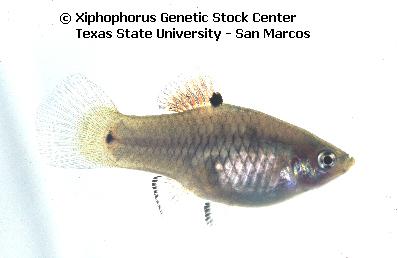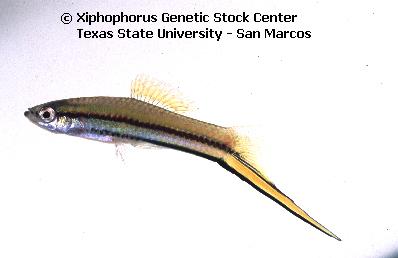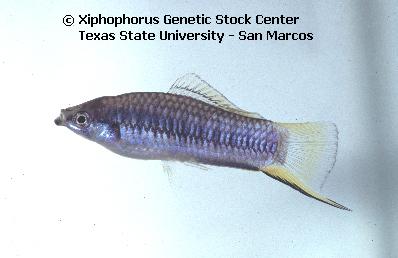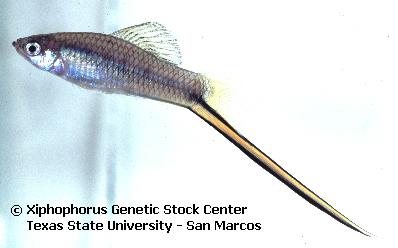Cyprinodontiformes vivíparos e ovovivíparos
Livebearer Cyprinodontiformes
Artigos - O Centro Genético de Linhagens de Xiphophorus
Articles - The Xiphophorus Genetic Stock Center
|
|
|
Cyprinodontiformes vivíparos e ovovivíparos Livebearer Cyprinodontiformes Artigos - O Centro Genético de Linhagens de Xiphophorus Articles - The Xiphophorus Genetic Stock Center |
||||||||||||||
|
|
|
The Xiphophorus Genetic Stock Centre - ( as we can become familiar with it at http://www.xiphophorus.org/ ) published at this website in June 2007 |
|
|
|
What are the Xiphophorus ? Xiphophorus is a freshwater fish genus comprised of 23 species. These fishes live in eastern drainages in Mexico, Guatemala, Belize and Honduras, with most of the described species living in Mexico. The taxa make up 3 groups, the Northern Swordtails, the Southern Swordtails and the Platyfish. If these names are familiar to you, there is a good chance that you have seen these fish at pet stores, as they are very popular with hobbyists. It was realized as early as the 1920's that one could make hybrids between the different species. These hybrids were normally viable and could produce subsequent generations of offspring. In some cases, one simply had to place one Xiphophorus species next to another in an aquarium, and they would reproduce. In many situations, the resulting hybrid fish that were produced would show traits from both parent species, and were intermediate in appearance. For example, several dominant pigment patterns derived from two fish strains would appear within F1 hybrids giving them characteristics of both species. In other cases, the hybrid fish were quite different from either parent, such as when fish developed beautiful red or yellow colours. In such situations, pigment patterns were derived from one of the species and became enhanced in the hybrid offspring. |
|
It was also realized by scientists in Germany and the United States, that hybrid fish sometimes also developed melanoma, one of deadliest skin cancers. These melanomas were derived from improperly regulated melanistic pigment patterns. Scientists immediately began to study Xiphophorus hybrids, since they realized that they had discovered an animal model that could be useful in the study of cancer. Genetic cross between two Xiphophorus species that leads to the development of melanomas: Today, we continue the work that was begun by the scientists in the 1920's and pursued by other researchers for the last 70 years. Our work focuses on studying melanoma and other cancers that form in hybrid fish.
Genetic experiments often require that special strains of genetically identical animals or plants be used to assure that results can be repeated in any laboratory and that differences are not due to environmental factors or to random variation found in almost any population of animals. Among vertebrates, genetically identical animals most often are produced by inbreeding for many generations between brothers and sisters; in each generation, about one-half of the genetic differences between the parents are lost. It comes as a surprise even to most scientists that one of the oldest and best defined groups of genetic strains consists of livebearing fishes of the genus Xiphophorus , the platyfishes and swordtails familiar to the tropical fish hobbyist. In the 1920s, the American biologist Dr. Myron Gordon and German biologists Haussler and Kosswig independently discovered that hybrids of a particular strain of the platyfish Xiphophorus maculatus and the swordtail Xiphophorus helleri developed cancers virtually identical to malignant melanomas in man. They traced the origin of these tumours to pigment cells of a platyfish colour pattern consisting of black spots on the dorsal fin. Genetic studies demonstrated that melanomas developed only in hybrids which had replaced both copies of a platyfish regulatory gene with swordtail forms which could not control proliferation of the platyfish pigment cells. This animal model was one of the first to prove that some cancers were inherited diseases; after 65 years, these fish still are used in cancer research in the United States, Germany, Canada, and Japan. Dr. Gordon realized that to identify precisely the genes responsible for development of cancer, genetically identical platyfish and swordtails would be needed. Therefore, in 1939, he established the Xiphophorus Genetic Stock Centre, housed at the American Museum of Natural History and the New York Aquarium until 1993, when transfer of the stock centre to Texas State University in San Marcos was completed. During its 55+ years, the stock centre has been directed by Dr. Gordon and Dr. Klaus D. Kallman in New York, and currently by Dr. Ronald Walter ( Texas State University, San Marcos ). Several of the original genetic strains of platyfish and swordtails developed by Dr. Gordon in the 1930’s still are available today; they are virtual genetic clones, the products in some cases of more than 80 generations of brother-to-sister matings. When Dr. Gordon began his genetic studies and field work in Mexico and Central America, only a half dozen species of Xiphophorus fishes were known to science. Today some 23 species have been described; representatives of all but one are maintained at the stock centre. Ongoing field studies by Drs. Kallman and Morizot continue to discover new species, and are critical in future preservation of the increasingly valuable genetic resources of the genus. No fewer than eight species are confined to extremely small geographic areas and are potentially threatened by human habitat destruction; one species already has been listed as endangered and another until recently was thought to be extinct. The Xiphophorus Genetic Stock Centre, by providing fish to the international scientific community for study, at the very least reduces collecting pressure on wild populations, and could in the future preserve the only living representatives of some species. As the science of conservation genetics has evolved, so have the breeding strategies of the stock centre, away from generation of new inbred strains to maintenance of maximal natural variability in newly originated genetic stocks.
Scientists in more than 30 laboratories in the United States, Canada, Mexico, Japan, and Germany work on Xiphophorus genetics and depend on strains available from the stock centre. In addition to supplying strains and consultation on husbandry and genetic questions, the stock centre makes custom hybrids for a variety of projects, producing hundreds of such fish each year at very affordable costs. Unlike most mammals, where fertile hybrids between species are difficult or often impossible to produce, Xiphophorus hybrids are almost always fertile and are extremely valuable for their genetic variability and their very specific susceptibilities for many different cancers. Extensive use of these hybrids for gene mapping has made the Xiphophorus gene map the fifth largest among vertebrates, exceeded only by maps of man, mouse, rat, and cow in numbers of genes assigned. The beauty of many Xiphophorus strains has attracted tropical fish fanciers for decades. The demand among cognoscenti for extraordinary fish like X. montezumae with a sword longer than its body, far exceeds the production capabilities of the stock centre, but surplus fish are made available to aquarists when possible. The present stock centre facilities hold some 1200 aquaria, balanced between 900 tanks for genetic stock perpetuation and 300 for hybrids for research projects. While this number may seem large, each new species or newly identified genetic strain necessitates some redesign of the overall management plan. Quality control at the stock centre must be impeccable to maintain integrity of the large numbers of genetic strains ( even fish manage to escape, and a " jumper " can mean disaster ). Most strains have been purposely bred to carry diagnostic morphological traits such as red and black pigment patterns. Each strain possesses a unique genetic " signature " which can be checked for assurance of stock purity. Individual broods are never mixed, and males and females are separated prior to sexual maturity. All parents of broods are preserved for later reference in the event of later questions. All these precautions take a great deal of time, but have been essential in maintaining stock integrity sometimes for 50+ years.
Only a few can be illustrated here to illustrate the amazing scope of Xiphophorus genetic research and the fascinating variety of its subjects.
|
|
|
Xiphophorus maculatus, from the Rio Jamapa, Veracruz, Mexico.
Females carry spotted dorsal, spotted side, dorsal red, and shoulder spot pigment pattern genes on their X chromosomes, while males additionally carry striped side and anal red genes on their Y chromosomes. Both strains develop malignant melanomas in hybrids with swordtails; the melanoma from Jp 163 A spotted dorsal pigment cells is spontaneous, while the melanoma from Jp 163 B spotted side cells develops very rapidly only after irradiation with ultraviolet light. Several other strains, including a recently collected wild Jp strain without red or black pigment patterns but with a beautiful blue iridescence, have been developed at the centre. These strains have been central in genetic studies of cancer for more than 50 years. |
 Xiphophorus maculatus female ( Jp 163 A ) |
|
Southern Xiphophorus helleri strain Cd, from Rio Jamapa, Mexico.
The genetics of its remarkable red, yellow, and green colour patterns still are unknown, but in closely related strains orange or green sword coloration is controlled by a single gene on the Y chromosome. A peculiarity of the Cd strain is the occurrence every few generations of almost all-male or all-female broods, a source of constant anxiety in its keepers. No cause for this deviation from normal sex ratios in this genetically uniform fish has yet been identified. |
 Xiphophorus helleri male ( Jamapa ) |
|
Pygmy swordtail, Xiphophorus multilineatus, Rio Coy, San Luis Potosi, Mexico.
A sex-linked polymorphism at a sex hormone-related gene produces four sizes of males maturing at different ages, from 6-9 months old for the smallest gold males to more than one year old for the largest blue males. Behavioural studies have shown that females prefer the large males which exhibit elaborate courtship displays, rather than the small males which do not court but mate by sneak attacks upon females. This complex polymorphism also occurs in other swordtail and platyfish species. Several northern swordtail species, including X. multilineatus, are found only in one short river system and could easily become endangered through habitat destruction.
|
 Xiphophorus multilineatus male |
|
Montezuma swordtail, Xiphophorus montezumae, Rascon strain, Rio Gallinas, San Luis Potosi, Mexico.
The " true " Montezuma swordtail was rediscovered by stock centre directors in Mexico in 1980, and has become a favourite among aquarists because of its spectacularly long sword. The black spotting of X. montezumae, unlike that of its sister species is not due to a sex-linked gene and does not lead to pigment cell cancers in hybrids.
|
 Xiphophorus montzumae male |
|
Original source text contributed by Donald C. Morizot, Steven Kazianis and Jay Kumar. ( The Xiphophorus Genetic Stock Centre ) |
|
|
Additional information : You can also read a very nteresting and motivating article about the Xiphophorus Genetic Stock Centre history fallowing this link - http://www.xiphophorus.org/100300s6/css/100300s6_1.htm Requests for live Xiphophorus fish or questions regarding the Xiphophorus Genetic Stock Center, its operation and services should be forwarded to the Director :
The Xiphophorus Genetic Stock Center Texas State University San Marcos 601 University Drive 419 Centennial Hall San Marcos TX 78666-4616 Phone: (512) 245-0357
ILAR Journal ISSN 1084-2020, 2001; Volume 42, Number 4. http://dels.nas.edu/ilar_n/ilarjournal/42_4/xiphophorus.pdf
2101 Constitution Avenue NW, Washington, DC 20418 www.national-academies.org/ilarjournal. It is circulated to members of the ILAR Associates program. ILAR Journal is indexed in MEDLINE.
|
|
|
© 2006 - 2011 All Rights Reserved e-mail : viviparos.com
While the content is in the public domain, some pages contain images and material that are copyrighted by others and used here with permission. Such information is available for private use, study or research. You should obtain permission from the copyright owner for other uses. Please carefully examine all the content and all linked pages for copyright restrictions and to secure the necessary permissions.
These data and information are provided with the understanding that they are not guaranteed to be correct or complete. Users are cautioned to consider carefully the provisional nature of these data and information before using them; such data and information are the singular responsibility of the user. |